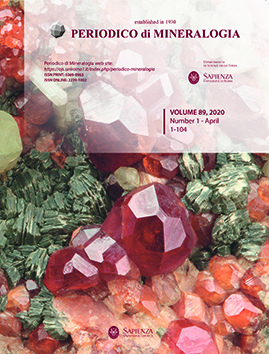The genetic relation between migmatites and granites, Tuyserkan area, Sanandaj-Sirjan metamorphic belt, western Iran: Constraints by mineralogy, geochemistry and thermobarometry
DOI:
https://doi.org/10.2451/2020PM875Keywords:
Migmatite, partial melting, granite, Tuyserkan, Sanandaj Sirjan zone, IranAbstract
The metapelitic migmatites and associated granites widely exposed in the Sanandaj-Sirjan metamorphic belt, (western Iran) are natural case to gain insights into the genetic links between the migmatite and associated granite. In Tuyserkan area, the intrusive of the Alvand batholith (middle Jurassic) invaded the metamorphosed pelitic rocks and resulted in hornfelses and migmatites in contact aureoles. Migmatitic leucosomes exhibit myrmekite and perthite textures, and are mainly composed of plagioclase, quartz, feldspar, biotite and garnet. Based on field geology and petrographic studies, migmatites in Tuyserkan area were proposed to be derived by fluid-absent and fluid-saturated partial melting. The reaction of Bt+And=Crd+Spl+Kfs+melt is the most important way for the metapelites remelting. The peak metamorphic conditions for derivation of the migmatites are estimated to be of approximately 700 °C and 3.8 kbar, reflecting a high-temperature/low pressure (HT/LP) metamorphism. The high-grade metamorphic minerals in these rocks, i.e., spinel, reflecting a pyroxene hornfels facies metamorphism. Leucosomes and leucocratic granites show substantial variations in trace and major elements. The constituent components of feldspars (K2O and Al2O3) are high in leucocratic granites. The Na/Na+Ca ratios of the leucocratic granites are relatively high in comparison with those of the leucosomes. The SiO2 content and the constituents of mafic minerals (MgO, FeO and TiO2) in leucosomes are more than leucocratic granites and show high contents of the Mg/Mg+Fe ratio. Leucocratic granites are higher in some HFSE elements (Y, Yb) and leucosomes are higher in the elements that preferably enter plagioclase (Eu). The most important feature of REE patterns is the difference in HFSE amounts between granites and leucosomes. Therefore, the rare earth element (REE) pattern of leucosomes and leucocratic granites in Tuyserkan area depict a lack of a genetic relationship between migmatites and the adjacent granites (leucocratic granites). Nevertheless, the isotopic age of leucocratic granites, mafic intrusions and migmatites confirm that leucocratic granites were emplaced after the formation of the migmatitis. As a results, we proposed that the migmatites formed through contact metamorphism due to the injection of mafic intrusions.


